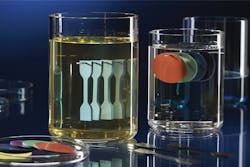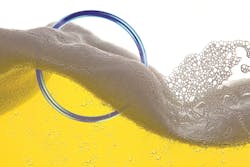Selecting the right sealing solutions in the food and beverage industry has become increasingly complex and challenging for engineers. What’s at the heart of these complex challenges? There are many factors. Consumer demands for variety are certainly a factor, as are regional standards and regulations that apply to the industry.
Take a brief look at how consumer taste for variety has grown just in the beverage market during the past 10 to 15 years. The average commercial drink dispenser has evolved from a push-button dispenser offering perhaps five options — regular or diet cola, lemon-lime, root beer or orange — to touchscreen technology capable of dozens of options and drink combinations. Further, craft beverages have also become big business for bottlers. Teas, enhanced waters, energy drinks and juices have all gained popularity and may be bottled in the same plants that bottle soft drinks. And that’s just beverages. The complexity of consumer choices grows even more when fast food restaurants and retail specialty food production are considered.
What about the differences in consumer tastes around the world? While North America consumes the highest level of corn-based fructose sweeteners in the world, many countries rely upon sugarcane-based sweeteners. Sugarcane’s more aggressive chemical makeup can degrade standard seals more quickly than corn sweeteners. Equally important, what about the regional food and beverage standards regarding material performance and sanitation to which engineers must comply?
This is where selecting the right sealing materials solutions has to start — not only with a list of specifications, but also with meaningful questions. And those questions must be asked early in the process to ensure the right selection.
The right questions lead to the right materials answers
The first questions about one’s engineering project should be: What do I want it to do? Where, and under what conditions must it do it? How long do I want it to last?
With those answers, decisions about selecting material for effectively sealing food and beverage equipment also must include answers to questions regarding temperature variations (both within the equipment and the environment in which the equipment will operate), ingredient combinations, bottling requirements and, of course, to what regional standards and regulations must I engineer?
Today’s global industry means engineering for multiple markets and for multiple regulatory compliance standards. Compliance with these diverse regulations is important and can be challenging and expensive, so it must be considered early. Where will the equipment be made and where will the equipment be sold?
The prevalent global standards are those of the United States and European Union (EU). The U.S. Food and Drug Administration (FDA) maintains various conformity standards and a list of authorized materials for use in the food and beverage industry. Primary for consideration is FDA-21CFR177.2600, which establishes the standards for rubber articles intended for repeated use in the food industry in the U.S. Another important player in global standards is NSF International, which independently validates standards compliance. In the EU, the European Regulation (EC) 1935/2004 establishes the guidelines for materials that come in contact with food and beverages. In China, GB 4806.x-2016 and GB 9685-2016 provide the framework for materials used in food and beverage applications.
Engineers must ask these questions from the start and share that information with their component supplier. It is more efficient to engineer the right material on the front-end of a project, than to re-engineer material in-process after a decision is made to sell the same equipment into another market as well.
To this point, suppliers capable of providing materials certified to meet a wide selection of standards offer important advantages to engineers. In addition to easing inventory and production complexities by eliminating the need for discrete sealing materials in various regions, materials that simultaneously meet certifications have been developed and tested to the highest levels of performance.
A variety of certified sealing materials, including those made of low-temperature fluorocarbon (FKM) material, highly fluorinated premium materials and EPDM material, are available. These materials meet U.S. and EU food industry requirements while resolving a variety of industry challenges including temperature and pressure extremes; resistance to cleaning solutions and chemicals in municipal water supplies; resistance to absorbing and transferring ingredient flavors and stability in acids, bases and polar solvents; and an ability to bond to either metal or fabric.
Finally, it is worth calling attention to the issue of Chinese food certification, which is an emerging industry challenge for global manufacturers. A variety of the U.S.- and EU-certified additives typically included in rubber formulas to enhance various performance characteristics in these regions are not currently certified for use in China. This has the potential to lower the day-to-day performance and long-term lifespan of rubber components being used in that country and to potentially introduce contamination and/or create a food safety issue. As a barrier to free trade, politicians have taken up this cause with Chinese leaders and asked for an expansion of approved materials in the near future.
Expanding and coordinating the list of approved chemical additives that are certified for use in these three regions would have a huge impact on an overall goal of providing manufacturers with a list of globally approved materials. In the meantime, manufacturers must work with suppliers who have the expertise and experience to guide them through this complex environment when considering global sales of their equipment. Tracking and maintaining compliance standards is an important responsibility. Choose a supplier that invests in maintaining annual certification of its materials and plants, reviews global regulatory changes and retains a robust database with records that verify a material’s compliance to current guidelines. The process of developing, testing and certifying materials to new standards can sometimes take three years or more.
Materials, the environment and all the variables
In addition to global material certifications, engineers need to ask questions about material characteristics. Specific considerations regarding physical, mechanical and chemical compatibility are necessary — and not simply with the food or beverage to be contained or the environmental elements to be kept out. Cleaning and sanitation are also important factors.
Today’s consumer-pleasing beverage landscape is challenging but not because formulas are complex. Soft drink formulas have always been secretive and complex. What is challenging is that combinations of ingredients never used together in the past are now being mixed in retail outlets — and the impact on sealing components can be unanticipated. Likewise, operating temperatures — an icy cold dispensing environment, for example — place challenges on materials, especially when they are unforeseen.
Consider this example: a dynamic seal on a beverage dispenser that was engineered to work — and did — when subjected to validation testing at room temperature. But when the equipment was installed and used in real-world settings, operational temperatures actually approached 0°C. As a result of these cold conditions, the sealing material became more leather-like and stiff and the solenoid couldn’t activate the beverage dispenser. Re-engineering the component using a material developed to handle extreme cold was successful but added time and cost into the resolution process for the customer.
In a bottling environment, resistance to flavor absorption is another important material characteristic that cannot be overlooked. A dedicated line runs one flavor. But smaller, boutique drink varieties may run on the same line; requiring frequent cleaning of the equipment. Materials that effectively resist flavor absorption are essential. Nobody wants white tea that tastes suspiciously like dark cherry punch.
Cleaning and sanitation is another critical consideration. Clean-in-place (CIP) and sterilization-in-place (SIP) cleaning conditions and sterilization procedures using steam or other cleaning solutions, including peracetic acid, are typically the most aggressive fluids equipment will encounter. Exposure to these fluids in the cleaning cycle is generally short, however, and does not impact the performance of the seals. But what happens when a cleaning solution at a restaurant is mistakenly left in the beverage dispenser or dispensing lines for longer than recommended — even overnight? The right material should not be negatively impacted, because this variable should be anticipated.
Variables over which the engineer has no control introduce risk into the validation and release process. This risk can be mitigated by use of more robust materials. The more conditions that a material has been evaluated to effectively handle, the more confident an engineer can be in knowing that the sealing product will function in the system. Materials must be robust enough to perform beyond ideal circumstances, beyond even the specification in some cases. Early consideration about how the seal must function, in what environment it must function, what fluids it must contain and seal against are critical. Only when the engineer and material supplier have such a dialogue can a sealing solution be collaboratively developed to do what it was intended to do.
Confidence it will do what you want it to do
Often, manufacturers of food and beverage equipment have few or no product testing capabilities available to validate the effectiveness and performance of components and materials they specify in the building of their products. This situation makes the selection of a supplier partner even more critical, as this partner often not only provides a material solution but also the validation that says that the solution will perform reliably as needed.
Manufacturers frequently conduct simple immersion testing of sealing material, measuring weight change and swelling over time. This is not an effective way to test seal performance, however, because it doesn’t test any of the meaningful properties of a sealing solution. It doesn’t answer important questions like: What is the sealing force? Does it maintain the seal? Does it leak? Such methodologies do not provide data relating to performance under various environmental conditions, nor do they offer analysis of performance during repeated dispensing cycles or cleanings.
Here’s another example to consider: A commercial oven installed and in use at a fast food chain exhibited inconsistent sealing. Despite thorough material testing for temperature, cycle performance and grease, there was an unanticipated variable in the restaurant environment. Sodium hydroxide cleaner, hot water and cooking grease were creating a mixture during cleaning cycles that attacked the seals, causing cracks and leaks. Despite a relatively short exposure to this mixture during cleaning, this unanticipated variable accelerated the degradation of the seal. Once the seal was re-engineered using a different material, the issue was resolved. But once again time and cost were introduced into the process. Risk from such unforeseen factors can be mitigated through early dialogue that explores what a material will likely be exposed to during the use — and even short-time cleaning — of the equipment.
Material testing is time-consuming and expensive. Mapping material properties during compression-stress-relaxation testing offers the best analysis of how a material will perform over a long period of time. A limited number of sealing material suppliers have the necessary laboratory equipment and analysis capabilities to conduct such complex studies. But those that do are able to maintain a database of proven sealing solutions from which valuable advance information can be identified. Critical data like this can help anticipate and prevent sealing challenges during the engineering phase of a project. With this data, materials can be evaluated against a database of CIP/SIP compatibility, flavor transfer characteristics and international regulations and certifications. This kind of proactive research results in sealing material solutions that function as needed in various regulatory and operating environments.
The selection decision
Your sealing material solution decision needs to begin with a conversation with your supplier. This conversation should include your engineering specs, of course, but also careful consideration of the environment, the variables (including those unforeseen) and the regulatory landscape in which your product must perform; and your supplier’s insight into materials that appropriately perform and comply, based upon their experience.
Time devoted at the start of the seal material solution selection process saves time in the production process and will optimize the life cycle of the product for your customer when it’s in service. While seal solutions may not be high-profile components, they are critical to meeting today’s demands in the food and beverage industry. With the industry focusing on longer and more variable operating cycles, custom designs, and a shift to smaller volumes and specialized products to meet consumer demands, sealing materials solutions will continually become more critical.
He holds a master’s degree in materials science engineering from the University of Michigan and a bachelor’s degree in chemical engineering from Michigan State University. Clark is a member of the American Chemical Society (ACS), Rubber Division of ACS, chairman of the Detroit Rubber Group (DRG) and a member of the International Society of Beverage Technologists (ISBT) and American Society for Testing and Materials (ASTM).
Geubert supports customers and engineers as a sealing technology expert in the food and beverage industry. He serves on committees within DIN, VDMA, ASME BPE and others. Geubert manages Freudenberg Sealing Technologies’ Application Engineering Process Industries global team with colleagues in Brazil and China.
About the Author
David Clark
Senior staff chemist for Freudenberg Sealing Technologies
David Clark, P.E., is a senior staff chemist for Freudenberg Sealing Technologies. He is an expert in the development of prototype elastomer materials for diverse industries including automotive, aerospace, food and beverage and energy. Clark supports manufacturing sites with production scale-up, process development, troubleshooting and failure analysis. He holds a master’s degree in materials science engineering from the University of Michigan and a bachelor’s degree in chemical engineering from Michigan State University.




